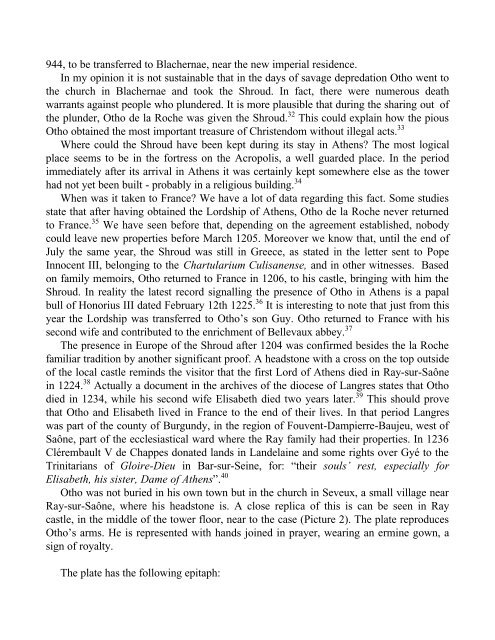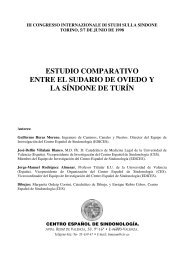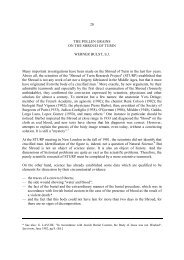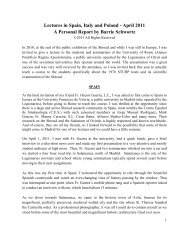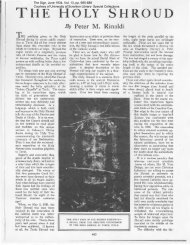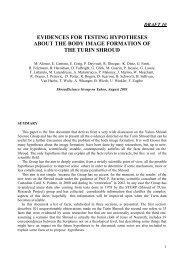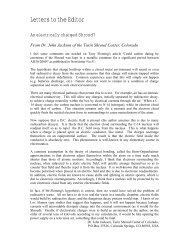Missing Years - Shroud of Turin
Missing Years - Shroud of Turin
Missing Years - Shroud of Turin
You also want an ePaper? Increase the reach of your titles
YUMPU automatically turns print PDFs into web optimized ePapers that Google loves.
944, to be transferred to Blachernae, near the new imperial residence.<br />
In my opinion it is not sustainable that in the days <strong>of</strong> savage depredation Otho went to<br />
the church in Blachernae and took the <strong>Shroud</strong>. In fact, there were numerous death<br />
warrants against people who plundered. It is more plausible that during the sharing out <strong>of</strong><br />
the plunder, Otho de la Roche was given the <strong>Shroud</strong>. 32 This could explain how the pious<br />
Otho obtained the most important treasure <strong>of</strong> Christendom without illegal acts. 33<br />
Where could the <strong>Shroud</strong> have been kept during its stay in Athens The most logical<br />
place seems to be in the fortress on the Acropolis, a well guarded place. In the period<br />
immediately after its arrival in Athens it was certainly kept somewhere else as the tower<br />
had not yet been built - probably in a religious building. 34<br />
When was it taken to France We have a lot <strong>of</strong> data regarding this fact. Some studies<br />
state that after having obtained the Lordship <strong>of</strong> Athens, Otho de la Roche never returned<br />
to France. 35 We have seen before that, depending on the agreement established, nobody<br />
could leave new properties before March 1205. Moreover we know that, until the end <strong>of</strong><br />
July the same year, the <strong>Shroud</strong> was still in Greece, as stated in the letter sent to Pope<br />
Innocent III, belonging to the Chartularium Culisanense, and in other witnesses. Based<br />
on family memoirs, Otho returned to France in 1206, to his castle, bringing with him the<br />
<strong>Shroud</strong>. In reality the latest record signalling the presence <strong>of</strong> Otho in Athens is a papal<br />
bull <strong>of</strong> Honorius III dated February 12th 1225. 36 It is interesting to note that just from this<br />
year the Lordship was transferred to Otho’s son Guy. Otho returned to France with his<br />
second wife and contributed to the enrichment <strong>of</strong> Bellevaux abbey. 37<br />
The presence in Europe <strong>of</strong> the <strong>Shroud</strong> after 1204 was confirmed besides the la Roche<br />
familiar tradition by another significant pro<strong>of</strong>. A headstone with a cross on the top outside<br />
<strong>of</strong> the local castle reminds the visitor that the first Lord <strong>of</strong> Athens died in Ray-sur-Saône<br />
in 1224. 38 Actually a document in the archives <strong>of</strong> the diocese <strong>of</strong> Langres states that Otho<br />
died in 1234, while his second wife Elisabeth died two years later. 39 This should prove<br />
that Otho and Elisabeth lived in France to the end <strong>of</strong> their lives. In that period Langres<br />
was part <strong>of</strong> the county <strong>of</strong> Burgundy, in the region <strong>of</strong> Fouvent-Dampierre-Baujeu, west <strong>of</strong><br />
Saône, part <strong>of</strong> the ecclesiastical ward where the Ray family had their properties. In 1236<br />
Clérembault V de Chappes donated lands in Landelaine and some rights over Gyé to the<br />
Trinitarians <strong>of</strong> Gloire-Dieu in Bar-sur-Seine, for: “their souls’ rest, especially for<br />
Elisabeth, his sister, Dame <strong>of</strong> Athens”. 40<br />
Otho was not buried in his own town but in the church in Seveux, a small village near<br />
Ray-sur-Saône, where his headstone is. A close replica <strong>of</strong> this is can be seen in Ray<br />
castle, in the middle <strong>of</strong> the tower floor, near to the case (Picture 2). The plate reproduces<br />
Otho’s arms. He is represented with hands joined in prayer, wearing an ermine gown, a<br />
sign <strong>of</strong> royalty.<br />
The plate has the following epitaph:


